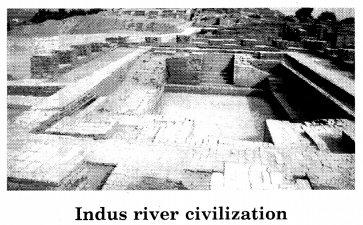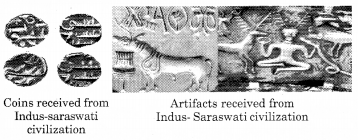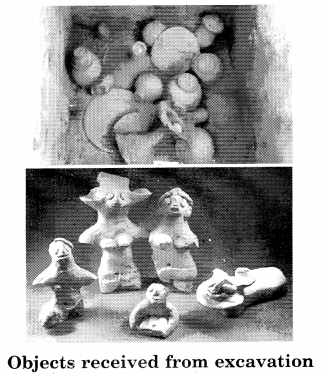RBSE Solutions for Class 6 Social Science Chapter 17 Our Past is part of RBSE Solutions for Class 6 Social Science. Here we have given Rajasthan Board RBSE Class 6 Social Science Chapter 17 Our Past.
| Board | RBSE |
| Textbook | SIERT, Rajasthan |
| Class | Class 6 |
| Subject | Social Science |
| Chapter | Chapter 17 |
| Chapter Name | Our Past |
| Number of Questions | 40 |
| Category | RBSE Solutions |
Rajasthan Board RBSE Class 6 Social Science Chapter 17 Our Past
Textbook Activity Based Questions and Answers
Activity
Question 1.
Imagine and discuss how people lived in ancient times. (Page 114)
Answer:
The ancient life would have been very different from the modem social life. It has been found from various archaeological excavations that there was lack of fire, agriculture and roads and means of transportation in ancient times.
Activity (Page 121)
Question 1.
Collect photos of Archeologically important places of Rajasthan ?
Answer:
Do youself.
Question 2.
Collect stones of different shapes and think if any tool can be made from them. Prepare some tools and exhibit them.
Answer:
Do this activities with the help your elders or teacher.
Learn & Inform
What is the contribution of family tree writers in the writing of history? (Page 115)
Answer:
Following has been the contribution of family tree writers in the writing of history :
- Important events right from birth to death were maintained in the ledgers kept by the family tree writers, which made the writing and publishing of history possible in present time.
- The tradition of family tree writing developed by the family tree writers is a convenient medium of knowing about history.
Question 1.
What did primitive man learn, discover and what useful things or figures did he make? Make a list with the help of your teacher. (Page 116)
Answer:
What did primitive man learn – Animal rearing, growing plants, farming, hunting, living in caves, etc. What did the primitive man discover – Copper, zinc and lead. What useful things and figures were made by primitive man – He invented cart and moved it with the help of wheels, he started making earthen tools with the help of potter’s wheel made of stone, he learnt to weave cloth.
Question 2.
Make a list of peculiarities of town planning in Sindhu – Saraswati civilization. (Page 119)
Answer:
Following is the list of major peculiarities of town planning in Sindhu Saraswati civilization:
- The buildings in the cities were spread like net.
- The roads intersected at right angles.
- The city was divided into rectangular blocks.
Textbook Exercise
Write the correct answers of Q. 1 and Q. 2 in brackets :
Question 1.
First excavation of Sindhu valley civilization was done at
(a) Mohenjo-Daro
(b) Harappa
(c) Kalibanga
(d) Lothal
Answer:
(b) Harappa
Question 2.
How old is Sindhu Civilization considered as compared to Christ?
(a) 2000 years
(b) 5000 years
(c) 2500 years
(d) 4000 years
Answer:
(c) 2500 years
Question 3.
What are the sources of knowing history?
Answer:
Following are the major sources of knowing history :
- Archaeological evidences
- Literary sources
- Family trees
- Old documents and diaries written by foreign tourists.
Question 4.
How did primitive human beings live?
Answer:
Primitive human beings led a nomadic life. They formed groups and roamed in the jungles in search of food. Hunting the animals and eat them, living in caves, was their daily routine.
Question 5.
What were the principle arms and tools of primitive human beings?
Answer:
Principle arms and tools of primitive human beings included- saw, knife, axe, hammer and wooden handle, etc.
Question 6.
What were the reasons of the development of the civilization in the plains of river banks?
Answer:
Following were the reasons of the development of the civilization in the plains of river banks:
- Availability of water in abundant quantity,
- Abundance of fertile land,
- Levelled land present in the nearby regions of the river,
- Presence of various types of animals near the river.
Question 7.
What are the important places of the Sindhu – Saraswati Civilization?
Answer:
Major places of the Sindhu – Saraswati civilization include – Mohenjo – Daro, Harappa, Kodiji, Chanhudaro (Pakistan), Ropar (Punjab), Lothal and Dholavira (Gujarat), Kalibanga (Hanumangarh district in Rajasthan).
Question 8.
Comment on town planning in Sindhu-Saraswati civilization.
Answer:
Town planning in Sindhu – Saraswati civilization was in a developed state. The city was divided into fort and low category brick buildings. The buildings of cities were spread like net. The roads intersected at right angles and the cities were divided into rectangular blocks. Conference room, market, chowks, bathrooms, etc. have also been found in excavations which testify to the well – developed planning of that time.
Question 9.
Write brief comments on world civilizations contemporary with Sindhu-Saraswati civilization.
Answer:
Following are the world civilizations contemporary with Sindhu – Saraswati civilization :
- The Nile River Civilization of Egypt – This civilization flourished in the north – west Egypt in Africa on both the banks of River Nile.
- The Dajla – Farat Civilization of Mesopotamia – In the Doaba of present day Iraq, on the banks of the Dajla and the Farat rivers, it flourished. The Sumeriyan, the Babylonian and the Assyrian civilizations also developed in this region.
- The Hwang – Ho Civilization in China – In the lower plains of the Hwang – Ho river, where fertile clay loam soil was found, this civilization developed.
Question 10.
Which are the important archaeological places of Rajasthan? Describe.
Answer:
Following are the major archaeological places of Rajasthan :
- Kalibanga – Kalibanga is situated near the banks of present Ghagghar river in Hanumangarh district of Rajasthan.
- Ahad – Ahad is a town situated near the banks of river Bedach in Udaipur. It was famous as the Copper Town.
- Gilund – Gilund (Rajsamand) archaeological town is situated 95 kms away in the north – east of Udaipur.
- Bagore – Bagore is situated on the banks of Kothari river in Bhilwara district.
- Balathal – The village named Balathal is situated 42 kms away in the east of Udaipur.
- Noah – Noah is situated 5 kms away from Bharatpur town.
- Chandrawati – Chandrawati is situated near Abu Road in the foothill of Mount Abu (Abu-Sirohi).
- Pachhmata – Pachhmata village (Rajsamand) is situated 100 kms away from Udaipur.
- Ganeshwar – It is situated on the banks of Kantali river in Sikar district.
- Bairath – Bairath is situated in Jaipur district.
Other Important Questions
Objective Type Questions
Question 1.
Which are the literary sources?
(a) Coins
(b) Stone plaques
(c) Buildings
(d) Stories
Answer:
(d) Stories
Question 2.
Which metal was the first to be discovered by man?
(a) Copper
(b) Iron
(c) Zinc
(d) Lead
Answer:
(a) Copper
Question 3.
When was Harappa discovered?
(a) In 1912
(b) In 1922
(c) In 1932
(d) In 1942
Answer:
(b) In 1922
Question 4.
Dholaveera is situated in-
(a) Punjab
(b) Gujarat
(c) Uttar Pradesh
(d) Rajasthan
Answer:
(b) Gujarat
Question 5.
On the banks of which river was the Vedic culture born?
(a) River Sindhu
(b) River Saraswati
(c) River Ravi
(d) River Ganga
Answer:
(b) River Saraswati
Match Column A with Column B
(A)
| Column A | Column B |
| i. Archaeological sources | a. Old stories |
| ii. Literary sources | b. Stone plaques |
| iii. Foreign tourist | c. Around 40 lakh years ago |
| iv. Origin of humans | d. Whensong (Hiuen Tsiang) |
Answer:
i – b
ii – c
iii – d
iv – a
(B)
| Column A | Column B |
| i. Mohenjo-Daro | a. Rajasthan |
| ii. Ropar | b. Gujarat |
| iii. Lothal | c. Punjab |
| iv. Kalibanga | d. Pakistan |
Answer:
i – d
ii – c
iii – b
iv – a
Fill in the blanks
1. Kalibanga is situated in …………. .
2. Sindhu – Saraswati civilization is ……………. old from the present.
3. In ancient literature, …………………. river has been considered as the mother of river Sindhu. .
4. In the fort of Harappa, the best buildings were its …………………. .
5. Civilizations of places named Ahad and Gilund are known as ……………. culture.
Answer:
1. Rajasthan
2. 4500 years
3. Saraswati
4. food grain godowns
5. Ahad
Very Short Answer Type Questions
Question 1.
What is meant by stone plaques?
Answer:
Writings inscribed on stone or metallic plates are known as stone plaques.
Question 2.
Write the names of the communities who prepared family tree.
Answer:
The communities of Rao, Bhatt, Barot, Jaga, Purohit (Panda) at pilgrim centre, Ranimenga, Helwa and Panjikar, etc. prepared family tree.
Question 3.
Write the names of two foreign tourists of ancient times.
Answer:
Whensong (Hiuen Tsiang) and Megastheneze are the names of two foreign tourists of ancient times.
Question 4.
What is meant by pre-historical period?
Answer:
The period from the birth of mankind up till the development of script (from the present up to 10000 years ago) is called as the pre-historical period.
Question 5.
Why is the pre – historical period also known as the Stone Age?
Answer:
The pre-historic period is also known as the Stone Age because during this period man used to obtain fire by rubbing of two pieces of stones and also used utensils and tools made of stone.
Question 6.
On which basis is the Sindhu – Saraswati civilization considered to be a very developed civilization?
Answer:
On the basis of remains which have been obtained, Sindhu-Saraswati civilization is considered to be a very developed civilization.
Question 7.
How did the Sindhu – Saraswati civilization become extinct?
Answer:
Probably, heavy floods, an epidemic, earthquake or any other natural calamity might have destroyed the Sindhu-Saraswati civilization and made it extinct.
Question 8.
Which are the Pre – Harappan and Harappan period places situated in Rajasthan?
Answer:
The Pre – Harappan and Harappan period places situated in Rajasthan include Karanpura, Bijnaur and Tarkhan wala Dera, respectively.
Question 9.
How many east Harappan and Harappan period archaeological places have been discovered from Rajasthan? How many of these places have been excavated?
Answer:
In Rajasthan, 100 east Harappan and Harappan period places have been discovered. Out of these, 6 have been excavated.
Short Answer Type Questions
Question 1.
How do we obtain information about the river valley civilizations which had originated in our country? Explain.
Answer:
Information about the river valley civilizations which had originated in our country is obtained from the ancient forts, old buildings, coins, utensils, stone and metallic tools, statues and other such things which have been obtained from excavation and which were being used by our ancestors thousands of years ago.
Question 2.
What is meant by archaeological and literary sources?
Answer:
- Archaeological sources – Eire those which are ancient in nature and have been collected by the archaeologists. Ancient monuments, forts, coins, stone plaques, etc. are known as archaeological sources.
- Literary sources – Literary sources are those which are obtained in written form in any language. Old stories, tales and the books written in any language Emd script are considered as literary sources.
Question 3.
What is meant by family trees?
Answer:
Along with traditions such as languages, scripts, literature, history writing, etc. writing family trees has also been a unique tradition. It is an easy medium to know about history. In these, important events right from birth till death are maintained in the ledgers kept by family tree writers.
Question 4.
Throw light on the life of pre – historical man in brief.
Answer:
Pre – historical man led a nomadic life. He lived in small groups and used to roam in the jungles in search of food along with the head or the leader of the group. Eating food by hunting animals, living in caves was the daily routine of pre-historical man. He used fire in order to protect himself from wild animals and made small and big sharp – edged tools from small and big pieces of rocks and used them.
Question 5.
Write a brief note on river Saraswati.
Answer:
River Saraswati – River Saraswati occupies an important place in Indian culture. That the Vedas were written on the bsinks of the SarEiswati is Em established fact. Vedic culture was bom on the banks of the river. Mount Shivalik is considered to be its source of origin and it traverses through Haryana and Rajasthan to Kutch. Subsequently, this river disappeared. Recent discoveries have shown that a cultured Emd a well-organized civilization originated and developed on the banks of the river Saraswati. The satellite pictures clearly show the complete route of this river.
Question 6.
Describe the town planning of the Harappan period.
Answer:
Town planning was in a developed state in the Harappan period. The buildings had thick brick walls with windows Emd doors, large oil tanks, drains near kitchens, places for keeping animals have also been found in the buildings. Some of the houses had wells within them and bathrooms have also been found in the houses. Ruins of the buildings show that houses were built according to the needs of the family. The buildings were very large Emd open.
Question 7.
Give a brief description of the archaeological place named Pachhmata (Rajsamand).
Answer:
The archaeological place named Pachhmata is situated 100 km away from Udaipur in Pachhmata village. This is an important place of Banas culture of Mewar region. Many valuable and artistic things such as embellished jar, bangles of oyster and green stone, earthen pots and two big furnaces have been found here.
Long Answer Type Questions
Question 1.
Give a detailed description of the Sindhu – Saraswati (Indus River) Civilization.
Answer:
When pre-historical man learnt farming, animal rearing, building villages and to fulfill his requirements, some people started producing things in larger quantity than required by them and they started

giving the things produced by them to others and obtained things of their necessity in exchange. At this time, trade developed gradually and towns started to be populated. In this manner, the Sindhu-Saraswati civilization developed gradually. In the year 1922, excavation at Harappa in Punjab, and later on, at Mohenjo – Daro in Sindh, established the existence of these civilizations: This civilization was spread across entire Sindh, Baluchistan, East and West Punjab, Uttar Pradesh, Gujarat and Northern Rajasthan. The geographical extent of this civilization was very large. Period of this civilization is estimated from 4500 BC to 2500 BC.

The most unique characteristic feature of this civilization was its excellent town planning. Conference rooms, markets, chowks, bathrooms have been found in the excavations of the towns of this civilization, which testify to the well – developed town planning of that time. Excavations at this site show that the city population was divided into three categories. The first were the rulers who lived in the fort, the second were the traders who lived in the city and the third were the labourers and the farmers doing manual jobs and producing food grains, etc. lived in the surrounding villages. Articles found in the excavation of the Sindhu – Saraswati civilization at all the places bear a similarity. We get an idea about the lifestyle and living standard of the people of that time. It is estimated that this civilization existed for nearly 1000 years.
Question 2.
Which are the pre – historical remains obtained from the major archaeological sites of Rajasthan? Describe in detail.
Answer:
Following pre – historical remains have been obtained from the major archaeological sites of Rajasthan-
- Kailbanga – During the year 1961 CE, excavation of two sand dunes provides remains of articles of pre-historic period. Articles found in excavation of these dunes are similar to the Harappan civilization.
- Ahad – Remains of utensils of stone, copper and earthen pots have been found from this place which is famous by the name of ‘copper town’.
- Gilund – Remains of utensils of stone, copper and earthen pots, similar to Ahad, have been found here.

- Bagore – Stone-age and copper-age articles and remains have been obtained from the excavation of a dune here.
- Balathal – Copper – age utensils, statues and other historical things have been found from Balathal.
- Noah – Apparatus made of copper and bones, iron axes, etc. supposed to be of copper age have been found here.
- Chandrawati – Ongoing excavations at this place have provided knowledge about people’s life, lifestyle and other activities during the medieval period. The ruins of forts and godowns have also been found. This place was the capital of the Parmar Dynasty.
- Pachhmata – Many valuable and artistic things such as embellished jar, bangles of oyster and green stone, shells and ornaments such as Lapis Lazuli (this blue – coloured semi – precious stone is found in Badakshan province in North – eastern Afghanistan) many types of earthen pots and two big furnaces have been found here.
- Ganeshwar – Articles of copper age have been found in large quantities from here.
- Bairath – This was the capital of Matsya janapada during Mahabharata peiod. Some plaques of Emperor Ashoka’s period have also been found from here.
We hope the RBSE Solutions for Class 6 Social Science Chapter 17 Our Past will help you. If you have any query regarding Rajasthan Board RBSE Class 6 Social Science Chapter 17 Our Past, drop a comment below and we will get back to you at the earliest.